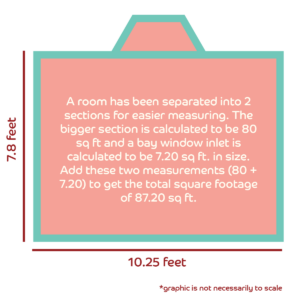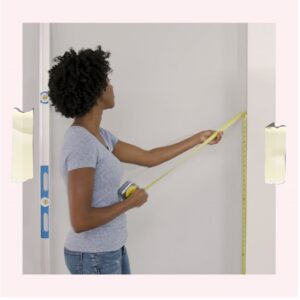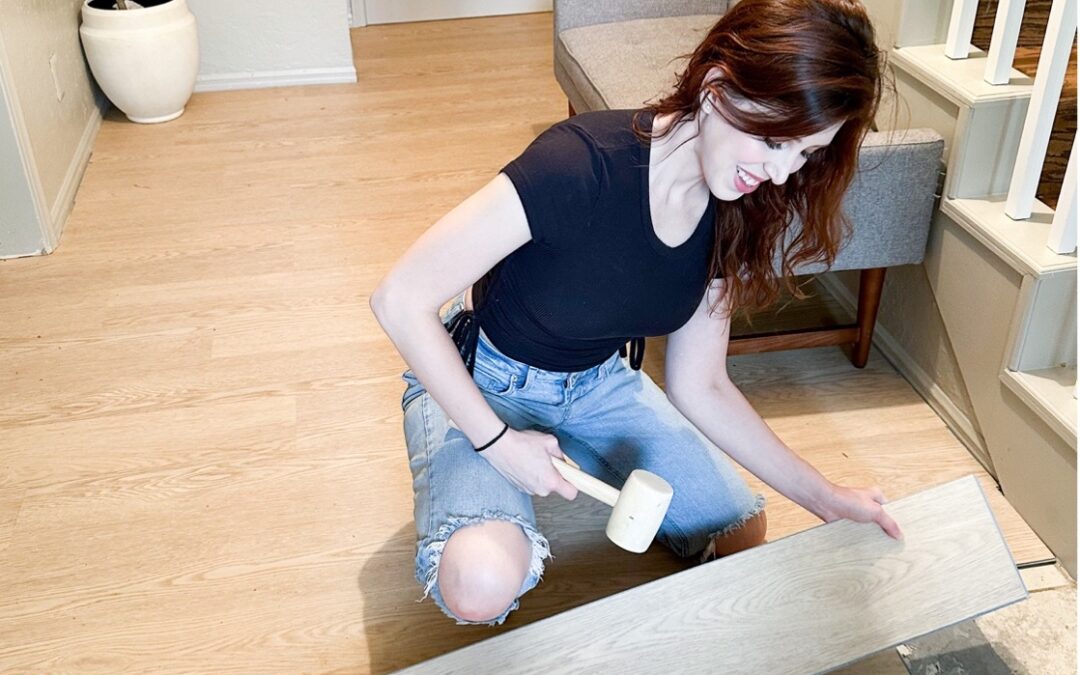Pictured above: Kelsey Mackall (A Dabbled Dwelling) prepares to install DuraDecor luxury vinyl planks in color Bungalow Beige from the popular Modern Maven collection.
We always wondered when all that math we learned in school would pay off. And here we are, ready to install our favorite DuraDecor Rigid Vinyl Planks and Tile or Peel and Stick Vinyl Planks and now we need the math skills again. This should be interesting…
Whether you want to revamp your bathroom or give your kitchen a makeover, you will need to take accurate measurements of your space to calculate square footage, budget accordingly, and plan for your purchase. Think about it: Before you can even install a new floor, you must know how much you will need and how much it will cost!
Thankfully, you can easily get an accurate idea of how much flooring you need and how much money to save up, by measuring your spaces like a pro. There’s no need to second guess your math skills when you have a tape measure, a calculator, pen, paper, and these helpful steps for how to measure for flooring installation.
Measure Length x Width – First, use your tape measure to take the length and width of the room receiving new flooring and write them down. Next, round each measurement up to the nearest inch.
- Example: If the length of your room is 10 feet, 2 and 2/3h inches, round up the total length to 10 feet and 3 inches.
Convert Measurements – Now, you will need to convert the length and width into measurements that are only in terms of feet. Divide the inches in each measurement by 12 and add that figure to the feet in each measurement. Write down these new totals, which will be the length and width measurements to use for new flooring.
- Example: If the length of the room is 10 feet and 3 inches, divide the 3 inches by 12 to get .25 feet. Add this figure to the 10 feet and your final length is 10.25 feet.
Multiply Measurements – Feeling like a flooring wiz yet? Take your converted measurements and multiply the room length by the room width to determine the square footage of the room. Write down this figure and label it as well.
- Example: If the room has a length of 10.25 ft. and a width of 7.8 ft., multiply these two measurements (10.25 x 7.8) to get the square footage of 79.95, or 80 sq ft.

Trickier Floorplans – You may have a room that’s not a perfect square or rectangle, maybe it’s an L-shape or a room that features an inlet. Try splitting the room into separate rectangular areas to make calculations easier! Measure each section, calculate the square footage of each section separately, write them each down, and then add them together to determine the total square footage of the entire area.
- Example: A room has been separated into 2 sections for easier measuring. The bigger section is calculated to be 80 sq ft and a bay window inlet is calculated to be 7.20 sq ft. in size. Add these two measurements (80 + 7.20) to get the total square footage of 87.20 sq ft.

Bonus Tips:
 Doors & Transitions – We hate surprise costs when we are budgeting for a new project. To eliminate these miscues when calculating your flooring installation, make note of any doors, closets, and transition areas in the room. Calculate each square footage and add them to your total for accurate planning.
Doors & Transitions – We hate surprise costs when we are budgeting for a new project. To eliminate these miscues when calculating your flooring installation, make note of any doors, closets, and transition areas in the room. Calculate each square footage and add them to your total for accurate planning.- Additional Rooms – If you have calculated the square footage within other rooms where you want new floors as well, add ALL the respective square footage figures together for the total amount of flooring needed.
- Measure Walls – You can use all these measuring steps, tips, and principles to measure your walls for planning accent wall projects as well!
Extra Flooring – Once you have the total area of all rooms and considerations, it’s very wise to add an additional 10%-15% of extra flooring to cover waste and plank cuts that are needed to complete the floor. Trust us, you do not want to run out of flooring towards the end of your installation. Multiply your total area by 1.1 to 1.5 (1.5 is recommended for trickier floorplans) to get your extra flooring amount. Add this to your total area and now you have your Grand Total!
As you shop for DuraDecor products at Home Depot, you will notice that each fabulous style offers different square footage of flooring per case, or sqft/case. Divide your Grand Total figure by the square foot per case of your fav DuraDecor style, and then round up this figure to the nearest whole figure to know how many cases you should purchase.
Now that you know how much flooring you need, it’s time to gather your favorite inspiration on our DuraDecor Pinterest and Facebook pages and have your favorite DuraDecor variety shipped directly to you!
Looks like all those trying years of math homework paid off after all… just don’t ask us about Calculus.


